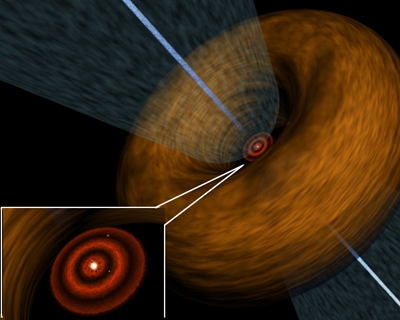New analysis of ALMA data for HL Tauri provides yet more firm evidence of baby planets around the star. Researchers uncovered two gaps in the gas disk around the star. The locations of these gaps in the gas match the locations of gaps in the dust found in the ALMA high resolution image taken in 2014. This discovery supports the idea that planets form in much shorter timescales than previously thought and prompts a reconsideration of alternative planet formation scenarios.
In November 2014, ALMA released a startling image of HL Tauri and its dust disk. This image, the sharpest ever taken for this kind of object, clearly depicts several gaps in the dust disk around the star.

Artist's concept of HL Tauri. The star is surrounded by the disk (shown in red) and thick envelope. The star ejects a bipolar collimated jet. Credit: Yin-Chih Tsai/ASIAA EPO
The team also found that the gas density is high enough to harbor an infant planet around the inner gap. Comparing the structure of the inner gap to theoretical models, the team estimates the planet has a mass 0.8 times that of Jupiter.
On the other hand, the origin of the outer gap is still unclear. The team suggested the possible existence of a planet 2.1 times more massive than Jupiter, but the present research cannot eliminate the possibility that the gap is made by the drag between the dust particles and the gas. To solve this question, more data are needed.
For more information about this study, visit:
http://www.almaobservatory.org/en/press-room/press-releases/962-alma-reveals-footprints-of-baby-planets-in-a-gas-disk
